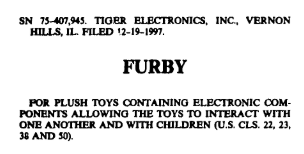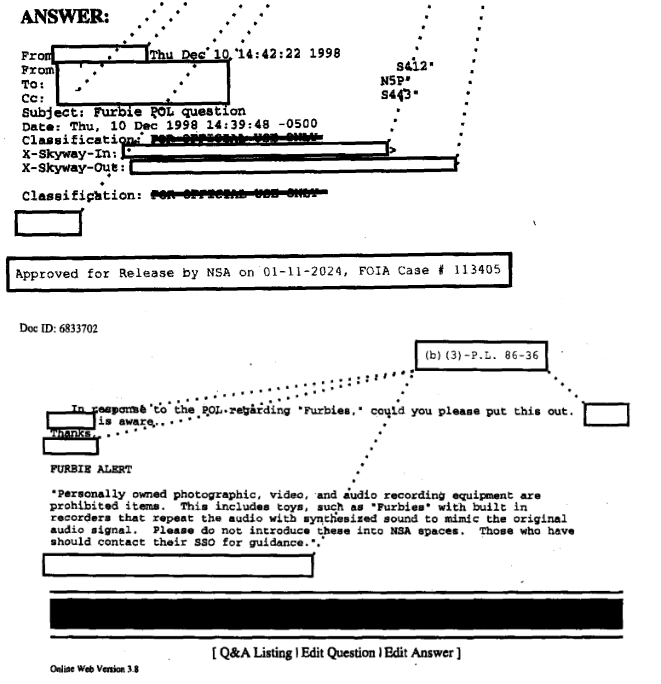Oh, the ‘90s. A decade of grunge, dial-up, Tamagotchis, boy bands…and the freakish little owl-like robot that was the Furby. If you were a kid at the turn of the century, you probably had at least one Furby that drove your parents insane with its gibberish chatter and occasional shrieking. However, it wasn’t just your parents that wanted to get rid of these strange little creatures. Did you know that the U.S. National Security Agency banned Furbies from their premises out of the fear that they were actually spies? Let’s dig into HeinOnline to explore the dark side of the Furby phenomenon.
The Toy Store Takeover
The Furby[1]1213 Off. Gaz. Pat. & Trademark Office TM1 (1998). This document can be found in HeinOnline’s Intellectual Property Law Collection. was first released by Tiger Electronics in 1998. It was a confounding new toy—was it a hamster? An owl? An alien? No one quite knew. But no one could have expected the incredible splash the Furby would make in the toy market. It became the hottest toy of the 1998-1999 holiday season, with 14 million sold in 1999 alone, at a price of about $35 each.

The main selling point of Furby was that it could “learn.” Once you activated your Furby, it would begin speaking an unknown language, referred to as Furbish. However, as the Furby “grew,” it would begin incorporating more English, creating the perception that it was “learning” from listening to people around it. Furbies also had the ability to communicate through each other through the infrared port between their massive eyeballs.
Additionally, one could condition the Furby to repeat certain pre-programmed words or phrases by petting it when it said those phrases—making it seem like they were listening and understanding. Kind of like a spy.
Furby vs. the Government
The Furby very quickly landed on the NSA’s radar. As early as December 1998, the organization began to question if Furbies (mistakenly referred to as Fropie’s), were okay on the premises, as “My understanding is that these guys contain a writeable chip. That would definitely be a security concern.”[2]NSA Furby Memo – Policy Questions (1998). This document can be found in HeinOnline’s U.S. Federal Agency Documents, Decisions, and Appeals database.

Thus went out the so-called Furbie [sic] Alert:[3]NSA Furby Memo – Policy Questions (1998). This document can be found in HeinOnline’s U.S. Federal Agency Documents, Decisions, and Appeals database.
Personally owned photographic, video, and audio recording equipment are prohibited items. This includes toys, such as ‘Furbies’ with built in recorders that repeat the audio with synthesized sound to mimic the original audio signal. Please do not introduce these into NSA spaces. Those who have should contact their SSO for guidance.

When questioned by the press about the Furby ban at NSA,[4]Jonathan Schnader, Alexa, Are You a Foreign Agent? Confronting the Risk of Foreign Intelligence Exploitation of Private Home Networks, Home Assistants, and Connectivity in the Security Clearance Process, 25 RICH. J.L. & TECH. 1 (2019). This … Continue reading they responded with a generic statement: “NSA/CSS prohibits use of any non-Agency owned photographic, video, and audio recording equipment in Agency work spaces. This includes any items with built-in recording features.”

Even the FAA was scared of Furbies—they worried that their technology could disrupt plane equipment. Most airlines ended up just asking passengers to remove the batteries from their Furbies before takeoff. The toy was also banned from the Naval Shipyard in Portsmouth, VA, due to security concerns.
Eventually, Tiger Electronics put out a statement laying the debacle to rest: “Furby is not a spy.”
Secret Spy? Or Strange Plaything?
The fears that Furby was an instrument for international spies was quickly debunked. Everything Furby does is pre-programmed—they aren’t actually recording anything…although some have argued that they actually do something creepier, in that their Furbies have “come back to life,” despite having no battery powering them—sometimes after years laying dormant.
Despite the espionage accusations, Furby continued to flourish, with Furby Babies, Furby Friends, and subsequent generations of Furbies released throughout the 2000s and 2010s. In fact, just last year Hasbro announced new Furbies with 5 voice-activated modes and over 600 reactions.
Get Posts Like These Delivered to Your Inbox
At the HeinOnline Blog, we aren’t spies, we’re not going to annoy your parents, and we aren’t going to wake you up in the middle of the night screaming gibberish. Subscribe today so you never miss a fun post like this, or any of our content updates, new databases and features, true crime stories, and much more!
HeinOnline Sources[+]
| ↑1 | 1213 Off. Gaz. Pat. & Trademark Office TM1 (1998). This document can be found in HeinOnline’s Intellectual Property Law Collection. |
|---|---|
| ↑2, ↑3 | NSA Furby Memo – Policy Questions (1998). This document can be found in HeinOnline’s U.S. Federal Agency Documents, Decisions, and Appeals database. |
| ↑4 | Jonathan Schnader, Alexa, Are You a Foreign Agent? Confronting the Risk of Foreign Intelligence Exploitation of Private Home Networks, Home Assistants, and Connectivity in the Security Clearance Process, 25 RICH. J.L. & TECH. 1 (2019). This article can be found in HeinOnline’s Law Journal Library. |



